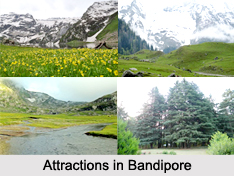 Bandipora is the place of tourist"s importance in Jammu and Kashmir. The Forest Training and Research Institute is located in Jammu and Kashmir. While on the contrary, Bandipora is the best place to trek and the adventurers who are interested in hiking.
Bandipora is the place of tourist"s importance in Jammu and Kashmir. The Forest Training and Research Institute is located in Jammu and Kashmir. While on the contrary, Bandipora is the best place to trek and the adventurers who are interested in hiking.
Forest Training and Research Institute
Forest Training and Research Institute is located at about 3 kilometres distance from the main town.
Darul-Ullom-Rehamia
Darul-Ullom-Rehamia or the School for Philosophers is the largest religious institution in Jammu and Kashmir. It is the largest Islamic institution of Kashmir Valley in Jammu and Kashmir.
Adventure in Bandipora
Bandipora is known for trekking, mountaineering and fishing. The famous Arin Nallah is home to one of the most exotic trout (Rainbow Trout, Silver Trout and Gray Trout).
Mt Harmukh
Mt Harmukh is the main attraction in Bandipora. It is located in the eastern side of the town. The commercial cabs ply on that route till Kodara that is the farthest point where the cabs stop, and there onwards the terrain becomes hilly and one has to track till the higher reaches of Mount Harmukh.
Sheera Sir
Sheera Sir acts as a base camp for all the mountaineering expeditions for Mt Harmukh. In the north lies Gurez, 86 km from Bandipora. Commercial cabs ply on this route during summers, however in winters the route remains closed due to heavy snowfall.
Forests in Bandipora
The place is surrounded by areas of scenic beauty and ranges such as Sarendar, Kudara, Vewan, Mowa and Tresangam, all of which are inhabited by the Gujjars ("Bakarwals").
Danishwar
Danishwar is regarded as one of the best places for Hindus. It is locally also called Chota Amar Nath. It falls on the road of Amarnath Yatra. It is a cave in dense forests of Erin. The pilgrims from both India and Pakistan (Pakistani Hindus) have to crawl about 60 meters to reach a cave where there are engraved features of Lord Shiva or Mahadeva. The local and the pilgrims used to go there on the Sharvan Purnima, the date on which Amaranth Yatra is being performed by the non governmental and governmental organisations for the Hindus of the world.
Related Articles
Tourism In Jammu And Kashmir
Culture of Jammu and Kashmir
Kashmir, India
Districts of Jammu and Kashmir



















